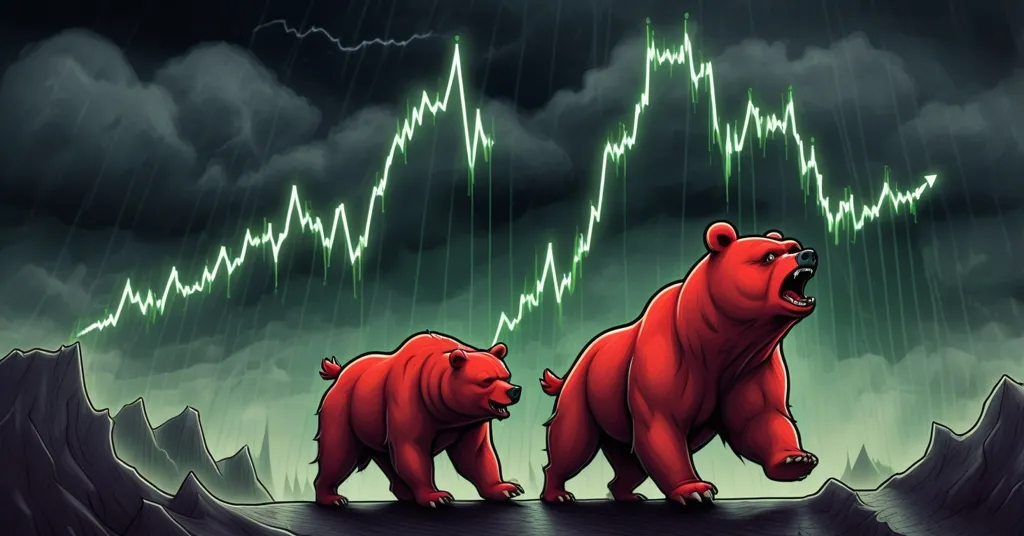Bitcoin Price Plunges: Binance Buy-Sell Ratio Hits Cycle Low—Rebound or Bear Trap?

Bitcoin Price Drop: Binance Taker Buy-Sell Ratio at Cycle Low—Rebound or Trap?
Bitcoin’s latest rollercoaster has traders on edge, with the price plummeting from a staggering all-time high above $124,000 to a shaky $113,467. As the market grapples with this near-10% pullback, a niche but telling metric—the Binance Taker Buy-Sell Ratio—has nosedived to a cycle low of 0.95, screaming bearish sentiment in the derivatives arena. Is this a hidden signal for a face-melting rebound, or a lure into a deeper bearish pitfall? Let’s dig into the chaos.
- Price Crash: Bitcoin drops from $124,000 to $113,467, testing critical support.
- Binance Ratio Low: Taker Buy-Sell Ratio at 0.95, a cycle bottom, hinting at heavy bearish bets.
- Contrarian Hope? Analyst Darkfost sees potential for a short squeeze and bullish reversal.
Bitcoin’s Wild Swing: From Euphoria to Edge
Just days ago, Bitcoin shattered expectations, blasting past $124,000 in a euphoric rally that had bulls popping champagne. But the party didn’t last—BTC stumbled hard, shedding nearly 10% to hover at $113,467. Now, it’s dangling by a thread above a price cliff between $111,000 and $113,000, a zone that includes the 100-day moving average at $111,140—a historical line in the sand for bounces. Above, the 50-day simple moving average at $116,114 looms as a hurdle; reclaiming it could reignite upward momentum. Fail to hold these floors, though, and we’re staring at a potential slide to $105,000 or worse. The daily charts aren’t exactly inspiring confidence either, with patterns like dojis and spinning tops—think of them as a tug-of-war with no clear winner—showing traders can’t make up their damn minds. For the latest technical analysis on Bitcoin’s support levels, the $111,000–$113,000 range remains pivotal.
This kind of volatility is Bitcoin’s bread and butter. Double-digit corrections are routine in bull cycles, often acting as a breather before the next leg up. But with lower highs forming on the charts, the question hangs heavy: is this a healthy cooldown, or the first crack in the bull’s armor?
Decoding the Binance Taker Buy-Sell Ratio: Bearish Overload?
For those not glued to crypto exchange dashboards, the Binance Taker Buy-Sell Ratio is a window into the psyche of derivatives traders on one of the planet’s biggest platforms. It measures the balance of aggressive buying versus selling—those “taker” orders that hit the market instantly. A ratio above 1 means buyers are charging in, a bullish sign. Below 1, as we’ve got now at a measly 0.95, sellers are running the show, painting a picture of raw pessimism. This is the lowest reading in the current cycle, a red flag that derivatives players are heavily betting against Bitcoin’s near-term prospects. Check out this report on Binance’s ratio hitting a cycle low for deeper context.
Derivatives, for the uninitiated, include futures and perpetual swaps—leveraged bets on price direction that can amplify market swings. When the ratio dips this low, it often means a crowd of traders are “shorting” BTC, expecting further drops. That’s where things get spicy. Analyst Darkfost, a sharp mind in the crypto trading scene, points out that such extreme bearish positioning can be a contrarian’s dream. Historically, lows like 0.97 in July 2023 and 0.963 in April 2024 marked turning points—within weeks, Bitcoin rallied 15% and 20% respectively as overconfident shorts got crushed. For more on historical correlations with Bitcoin price rebounds, the data is worth a look. Picture a packed bet against BTC’s price; if it suddenly spikes, those shorts scramble to cover losses by buying back at higher prices, fueling a rapid “short squeeze” upward. Could we be on the cusp of a similar slap to the bears?
Bullish Rebound? The Short Squeeze Setup
Let’s not sugarcoat it—there’s a real case for optimism here. Those historical rebounds after ratio lows aren’t just flukes; they reflect a market dynamic where sentiment extremes often flip. On-chain data backs this up to a point: negative funding rates in perpetual futures (where shorts pay longs to hold positions) signal heavy bearish bets, mirroring the Taker Buy-Sell Ratio’s story. If Bitcoin holds above $111,000–$113,000, a sentiment shift could trigger that squeeze, sending prices rocketing as leveraged players get burned. It’s the kind of move that reminds us why Bitcoin remains the heartbeat of this financial revolution—no altcoin noise can drown out its raw power to wreck overconfident traders. For insights into Bitcoin’s short squeeze potential, the dynamics are fascinating.
Zooming out, Bitcoin’s broader trend still looks bullish. Year-to-date gains are massive, and corrections like this are often just pitstops in a post-halving bull run (assuming we’re post-2024 halving based on timelines). Institutional players keep stacking BTC as an inflation hedge, and retail FOMO could kick back in if key levels hold. A bounce here wouldn’t just be a technical win—it’d be a middle finger to the doubters betting against decentralization’s poster child.
Bearish Trap? Why This Time Could Be Different
Before you go all-in on hopium, let’s play devil’s advocate with some brutal honesty. Historical patterns are cute, but they’re not gospel—especially in a macro environment that’s anything but normal. Interest rate hikes from the U.S. Federal Reserve could tighten liquidity, spooking risk assets like Bitcoin. Regulatory saber-rattling globally, from the EU to the U.S., keeps casting shadows; a harsh crackdown could tank sentiment overnight. And let’s not ignore on-chain red flags: exchange inflows are creeping up per Glassnode data, suggesting some holders—maybe even whales—are cashing out at these lofty levels. Weakening demand plus bearish technicals like those lower highs? That’s a recipe for a deeper gut punch if support cracks. For a broader perspective on Bitcoin’s price volatility and market indicators, the economic factors are complex.
Derivatives data like the Taker Buy-Sell Ratio isn’t a magic 8-ball either. Sure, past squeezes happened, but what if this bearish overload reflects genuine market exhaustion after a $124,000 peak? Back in March 2020, extreme sentiment preceded a crash, not a rebound, thanks to external shocks. Context is king, and today’s geopolitical mess—think trade tensions or energy crises—could easily outweigh historical parallels. Plus, over-leveraged traders are playing with fire, and Bitcoin’s notorious for burning the cocky on both sides of the trade. Derivatives are a casino, and right now, the house looks pissed. Dive into community thoughts on bearish sentiment around this ratio for varied takes.
Bitcoin’s Bigger Picture: Speculation vs. Decentralization
Stepping back, this whole saga—derivatives metrics, leveraged bets, short squeezes—feels like a weird detour from Bitcoin’s roots. This is supposed to be peer-to-peer money, a middle finger to centralized control, not a speculative playground for Wall Street wannabes. Don’t get me wrong; derivatives bring liquidity and price discovery, and hell, even altcoins like Ethereum with their staking gimmicks play a role in pushing adoption by filling niches Bitcoin shouldn’t touch. But are we trading decentralization for casino gains? Every time a trader gets liquidated on a 100x bet, it’s a reminder that Bitcoin’s ethos of freedom and privacy gets buried under greed. For a discussion on what a low Buy-Sell Ratio means for Bitcoin’s price, the implications are worth exploring.
That said, markets are markets. Sentiment indicators like this ratio still matter because they reflect the war between fear and euphoria driving BTC’s price. And let’s be real—Bitcoin’s resilience through cycles of hype and despair is why it’s still king. Even if altcoins siphon off some speculative heat, BTC’s derivatives data tells the truest story of where this revolution’s pulse is at.
Beware the Wolves: No Room for Shills
One quick gut check before we wrap this up: beware of grifters peddling “guaranteed pumps” off metrics like this ratio. Crypto’s crawling with wolves in analyst clothing, shilling fake signals or $200,000 price predictions with zero basis beyond their own pump-and-dump schemes. We’re here to drive adoption and cut through the noise, not feed you bullshit. If someone’s selling certainty in a market this wild, they’re lying. Full stop.
What’s Next for Bitcoin Traders?
So, where does this leave us? I’m cautiously leaning toward a rebound—Bitcoin’s knack for screwing over the overconfident bears is hard to bet against, and historical squeezes are a real pattern. But I’d be a fool to ignore the glaring risks, from macro headwinds to brittle support levels. The next few days are make-or-break; watch $111,000–$113,000 like your stack depends on it (because it might). Whether we’re prepping for another moonshot or bracing for a bloodbath, Bitcoin’s volatility is the only constant. Stay sharp, stack sats, and don’t let the market play you for a sucker. For more on Bitcoin’s price correction and derivatives analysis, the data suggests it’s a pivotal moment.
Key Takeaways and Questions on Bitcoin’s Market Dynamics
- What’s behind the Binance Taker Buy-Sell Ratio dropping to 0.95?
It shows heavy bearish sentiment in Binance’s derivatives market, with aggressive selling outpacing buying—a sign traders are betting hard on Bitcoin’s decline. - Why might this low ratio hint at a bullish reversal?
Past lows, like in July 2023 and April 2024, often marked bottoms, with overextended shorts getting squeezed as prices rallied 15-20% shortly after. - Which Bitcoin price levels matter most right now?
Support at $111,000–$113,000 is critical; holding it could spark recovery, while breaking below risks a drop to $105,000. Resistance at $116,114 is the next hurdle. - What are the biggest near-term risks for Bitcoin?
Beyond failing support, macro factors like rate hikes, regulatory threats, and rising exchange inflows signal potential selling pressure and a deeper correction. - How does this fit into Bitcoin’s long-term bull cycle?
Despite the dip, BTC’s uptrend holds strong in a likely post-halving bull phase, though whether this pullback is a brief pause or a trend shift depends on market reaction.



